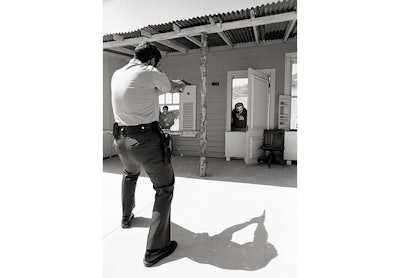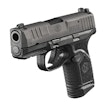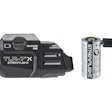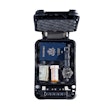 Photo: Photo: Los Angeles County Sheriff’s Department
Photo: Photo: Los Angeles County Sheriff’s Department
We live in a world where everything is now driven by the latest technology, and sometimes that's OK. In police work I would never wish to return to those ancient cumbersome flashlights, or Nash Rambler patrol cars, or the lack of portable radios or body armor. But today even our firearms have become tech heavy.
Today in police units we see polymer-framed pistols and 21st-century patrol rifles with lights, lasers, and expensive electronic sighting systems mounted on Picatinny, KeyMod, or M-LOK rails. New and improved systems in shotguns, pistols, and rifles promise more accuracy and lighter weight and they fire scientifically engineered "magic bullets." But I have to ask, just how light should a weapon be?
As a combat MP in Vietnam I was issued an M-14 A1 selective fire rifle with bipod, and when I wasn't humping that beloved 11.2-pound weapon, I carried an M-60 machinegun (24.4 pounds). The infantry troopers we were attached to carried the lighter and more modern M-16s, and some derisively called my M-60 "the pig." Then came January 1968 and the Tet Offensive. In the fierce house-to-house combat, that 7.62 NATO round spitting out of "the pig" (or that old M-14) proved much more effective than that pipsqueak "Mattel" plastic M-16 and that 5.56 bullet smacking uselessly against the city walls.
I am now a retired policeman on a fixed income. When I retired, I moved out of Los Angeles to a smaller, quieter city. However, like the proverbial old fire horse, I might be out to pasture, but I'm still prepared to respond to the fire bells. I attend all the gun shows and regularly practice my shooting drills. I still read all the police and military tactical periodicals. I have become a prepper and I volunteer as a police reserve.
When I see or read about the new technical-tactical weaponology, I can't help myself. I lust after all that cop gear, and I would buy it all but for two problems: I can't afford it, and my wife would kill me. And it's not because I don't own guns; I own a safe full of them. But they are not from this high-tech generation.
So let's get aboard the "way-back machine" and travel back to 1970 when I first joined the Los Angeles County Sheriff's Department. My previous sidearm for my three years as an MP had been the same one my father carried in WWII, the ancient but reliable .45 caliber 1911 pistol. But when I joined the LASD, I was issued an anemic .38 caliber Smith & Wesson model 15 revolver. I had to "unlearn" the semi-auto pistol and learn to shoot the service revolver.
Over the years, LASD tried upgrading the six-shot revolver with new loadings for the .38 police special round. Hollow point and plus "P" rounds helped, but we had to stay under the velocities of the scary and politically incorrect .357 Magnum. Eventually technology overcame inertia and we went to semi-auto 9mm pistols, first the S&W model 59, and later the Beretta 92.
You probably will find this hard to believe, but the standard issue "patrol rifle" in my day was a Winchester model 1894 .30-30 carbine with a saddle ring and marked "Los Angeles County Sheriff's Department." These rifles usually remained in the station armory, but as a man-killer, the '94 was prized by cowboys and Indians alike. My grandfather loved his when he rode with the Dorado troops of Pancho Villa. This old rifle has taken more deer in the U.S.A. than any other. And even the great Colonel John Dean "Jeff" Cooper opined that a '94 Winchester with ghost ring sights could hold its own in power and accuracy against the AK-47 out past 25 yards. In the March 1, 2015, issue of Shotgun News, author James Tarr tested and validated Cooper's claim.
Our issue shotgun was the Ithaca model 37 DSPS "Deer Slayer Police Special" 12 gauge with an 18-inch barrel. I loved this reliable Browning-designed shotgun. The LASD's model 37 differed from LAPD's model 37 in that you could hold down the trigger and fire all the rounds just by cycling the slide. The expended rounds ejected straight down from the receiver, allowing even left-handed deputies easy operation. The Ithaca barrels were prized because of their accuracy when shooting heavy slugs. My academy class fired scope-mounted versions out past 100 yards at the Wayside Range. It was all fun and games until some foolish cadet killed a gopher who popped his head up downrange.
At that same trip to the rifle range we familiarized ourselves with the LASD issue submachinegun. It was not the Thompson M1-A1, but the Reising model 50 in .45 caliber. This WWII Marine Corps weapon was an unusual selective fire sub-gun weighing only 6.75 pounds and capable of firing 550 rounds per minute from a 20-round magazine. The weapon did not do well in the jungles of the Pacific, but when cleaned and oiled it operated just fine in Los Angeles. Maybe you (like me) are a fan of the MP-5, but I would not feel undergunned clearing a building armed with a Reising.
Finally we shot the Remington model 8 in .35 Remington. Having recently come home from the Army, it felt a lot like my M-14. It was very accurate and pointed naturally for me. I would later learn that what we shot was probably a POE (The Peace Officer Equipment Company) manufactured Remington (designated Special Police model 8, or 81 depending on when it was manufactured). This weapon accepted 5-, 10-, and 15-round magazines. The Model 8 blazed its name in history when on May 23, 1934, the legendary Texas Ranger Frank Hamer used one in the ambush that ended the infamous careers of Bonnie and Clyde.
Later in my career I carried the short-barreled (stakeout) version of the Ithaca Model 37 while working the LASD Prison Gang Surveillance Unit. I was in good company because this was the same weapon carried by Det. Ricardo Tubbs (Phillip Michael Thomas) on the then hit TV show "Miami Vice" and as backup by the gutsy Space Marine, Corporal Hicks in the movie "Aliens." Mine was named T-2 for another movie, "Terminator II." The stakeout version of the Ithaca Model 37 was handy when working out of my non-police vehicle in plainclothes and when making numerous dynamic entries and house clearings. I kept a variety of special purpose shotgun rounds on my vest; tear gas, or Ferret chemical shells, slugs, and exploding bird rounds that I employed like flash-bangs or as guard dog medicine.
Maybe you work for some small jurisdiction with a limited budget or you no longer have that coveted tactical assignment like SWAT. Or maybe, like me, you have retired, and smart as you are, you want to "stay ready, so you don't have to get ready." But you can't buy every new "Professor Gadget" innovation or latest trendy tactical enhanced munitions minutiae. My advice is don't give up the ship. In my experience most violent offenders can't tell if the round that hit them was from a red dot, green lasered, scoped .300 Blackout, or a 30-30 Winchester. And bullpup shotguns are cool, but so was that short Ithaca. There are good reasons why they became classic guns. Becoming proficient with your old retro guns and gear only takes a little extra practice. Go with what you know.
Richard Valdemar retired from the Los Angeles County Sheriff 's Department in 2004. He has more than 25 years of experience in anti-gang operations and is a noted authority on street and prison gangs and their cultures. He serves on the advisory board of POLICE Magazine.














